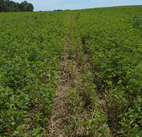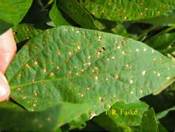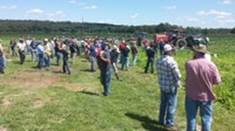Good afternoon,
It’s August already and most of the corn in our area should have been pollinated by August 1. Corn pollination should not be a problem this year; pollination problems generally occur during years of dry and hot weather. However, the excessive water and flooding may cause corn to develop at different rates in the same field affecting tassel and silk emergence and pollination. This may result in grain maturing at different times in the same field. Once pollination happens, we can expect 60-65 days until maturity. Once the corn reaches physiological maturity, it is safe from a killing frost. To find out more about corn pollination, see the attached article.
Western Bean Cutworm counts were low again this past week with only one moth caught in the four traps around the county. I’ve been receiving several questions about the value of silage in the field this year. It is difficult to determine the value of the corn silage in the field with the growing conditions we had this year and the uneven corn and lack of consistent nutrient uptake. However, there is a method of pricing corn value in the field for use as silage. See the article below for more information on this topic. The big question with this corn will be the nutrient value of the silage. So if you are considering harvesting corn as silage, it is recommended that you take send a sample to a lab for analysis.
Ohio State University Extension is asking farmers in the Maumee River Basin to help with a water monitoring research project looking at Dissolved Reactive Phosphorus (DRP) losses from fields. Increases in DRP in the watershed have been tied to increased occurrences of Harmful Algal Blooms in Lake Erie. The data collected will help better quantify actual losses from an economic and environmental standpoint, leading to tools that can target high risk fields so cost effective Best Management Practices can be designed that maintain crop productivity while reducing phosphorus losses. Read the attached article I submitted to the news media this past week to find out how you can volunteer a field for this study in order to find out what nutrients you may be losing through your field tile. If you are interested in participating in this research, contact me before September 1 and I’ll get you additional information.
Water Quality Monitoring News Release
There will be a Pumpkin Field Day August 20 at the Western Research Station in South Charleston. Topics include Current and Unregistered Fungicides for Powdery Mildew, Aerial Imagery Used to Advance Early and Late Season Pest Management in Cucumbers and Pumpkins, Downy Mildew Sentinel Trial, Impact of Insecticides and Fungicides on Squash Bee and Honey Bee Populations, and Row Covers and Trap Crops. If you are interested in attending, see the attached flyer and register by August 13.
There will be a Precision Agriculture Day: Combine and Drone Technology that will be held Friday, August 21 at the Champaign County Fairgrounds in Urbana. This event will feature presentations on decision agriculture, aerial imagery, utilizing field data, nutrient management, My John Deere and MyShed-Case IH. Some of the presenters include Dr. John Fulton, the new OSU specialist in precision ag technology, Ohio Farm Bureau, Integrated Ag Services, and a panel of farmers utilizing aerial imagery technology. Demonstrations from Case IH, John Deere, and Lexion dealers on combine setup for harvest will take place in the afternoon. Live drone flying demonstrations will also occur during the day. See the attached flyer for more details and register by August 12 for a lunch count.
Champaign County Precision Ag Day
Have you seen any bagworms in your trees or shrubs this summer? Bagworms on a shrub or tree can cause excessive defoliation. A severe infestation may kill the plant within one or two seasons. Bagworms do the most damage on arbor vitae and cedars, but will attack pines, junipers, spruce and at least 130 other trees and shrubs. They may not harm the deciduous trees, but they spread from these trees to more susceptible evergreens. For more information about treatment of this pest, see the attached article. The longer a homeowner waits to provide treatment, the more difficult it becomes to control this pest.
Upcoming local events include an Extension Advisory Committee meeting Thursday, August 6 starting at 7:30 am at the Friendship Gardens of Hardin County. Ag Council will be meeting at 7:00 am this Friday, August 7 at Henry’s Restaurant. Feel free to join us to get updated on the latest agriculture and county information. I plan to share information from the V12 GreenSeeeker readings and updated yield projections for our two Corn Response to Nitrogen plots. A Regional Dairy meeting will be held Monday, August 10 at St. Henry High School, starting at 10:00 am. See the attached flyer for more details. Below are additional agronomy articles that you may be interested in reading.
Aug 2015 Regional Dairy Meeting Flyer
Mark
Pricing Corn Silage Update (August 2015) – Bill Weiss, Dianne Shoemaker
Estimate grain yield using the Thomison (2013) method or other approach. On average, in the lower Midwest, you get about 1 ton of corn silage (35% dry matter (DM) per 7.5 to 8 bushels of corn. Therefore, if the estimated grain yield is 140 bu/acre, expected silage yield would be 140/8 = 17.5 tons. However, under abnormal growing conditions this may underestimate forage yield (i.e., there will be less than 8 bu of grain per ton). Based on nutrient values, corn silage is currently worth $40 to $45/ton (at 35% DM) as it comes out of the silo. You need to deduct shrink and storage (estimated at $9/ton) and cost of harvest and filling (estimated at $6.90/ton – chop, haul and fill for a bunker silo. This means the maximum a dairy farmer should pay for standing corn is ~$24.10/ton. For more information and examples, go to http://corn.osu.edu/newsletters/2015/2015-24/pricing-corn-silage-update-august-2015.
Soybean Aphids and Western Bean Cutworm Updates – Andy Michel
Two insects that growers may be on the lookout for are soybean aphid and western bean cutworm. The recent rain events may have also carried with them early season soybean aphid migrants that are possibly now in soybean fields. The forecast for this week also looks favorable for soybean aphid population growth. Numbers are not likely to reach threshold this week, but you may want to check soybean to see if aphid numbers are beginning to build. Remember that there is usually a time delay before the appearance of natural enemies which will help keep populations low. To continue reading this article, go to http://corn.osu.edu/newsletters/2015/2015-21-1/soybean-aphids-and-western-bean-cutworm-updates.
Managing Alfalfa Stands Damaged by Waterlogging – Rory Lewandowski, Mark Sulc
We are receiving reports and have personally observed fields of alfalfa injured by the excessive soil wetness the first half of this growing season. Generally, waterlogging injury appears as stunting with a general yellowing of the entire plant, a result of nitrogen deficiency due to inactive N-fixation in waterlogged soils. Anaerobic respiration occurring in the plant under low soil oxygen also produces compounds that are toxic to the plant. You should evaluate your stands in the next few weeks by counting the number of live plants per square foot, based on the age of the stand. To finish reading this article about damaged alfalfa stands, go to http://corn.osu.edu/newsletters/2015/2015-23/managing-alfalfa-stands-damaged-by-waterlogging.
Fungicide Applications Depend on Soybean Growth Stages and Presence of Disease – Anne Dorrance
We have had lots of inquiries this past week on the benefit or lack-there-of from fungicide applications on soybean in Ohio. There are several factors that I have found in the past that can influence this return on investment: growth stage of the plant, conditions that are favorable for disease and the presence of inoculum. I have outlined how these may influence the outcome for a couple of our most yield limiting late season diseases: Sclerotinia stem rot (white mold) and frogeye leaf spot. To continue reading about soybean fungicide applications, go to http://corn.osu.edu/newsletters/2015/2015-21-1/fungicide-applications-depend-on-soybean-growth-stages-and-presence-of-disease.
2015 Manure Science Review – Glen Arnold, Sam Custer
The 2015 Ohio Manure Science Review (MSR) will be held in Darke County on Wednesday August 12 at Mississinawa Valley High School, 10480 Staudt Road, in Union City, Ohio, close to the border with Indiana. The MSR is an educational program designed for those involved in any aspect of manure handling, management, or utilization. The MSR consists of both classroom style presentations and field demonstrations of manure equipment. Registration opens at 8:15 am and the program begins at 8:45 am. The afternoon field demos conclude at 4:00 pm. For more information about the upcoming Manure Science Review, go to http://corn.osu.edu/newsletters/2015/2015-23/2015-manure-science-review.
Mark A. Badertscher
Agriculture and Natural Resources Educator
OSU Extension Hardin County
1021 W. Lima Street, Suite 103, Kenton, OH 43326
419-674-2297 Office





